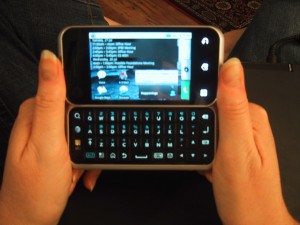
I have been using a Motorola BACKFLIP as my primary phone on AT&T for the last month. It is my first experience with the Android OS and smart-phones in general (my previous phone was a Motorola Razor V3xx “feature” phone), as well as my first full QWERTY keyboard on a phone. Overall it has been a positive experience. For the rest of my review, keep reading…
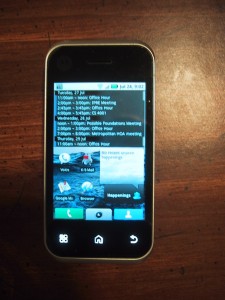
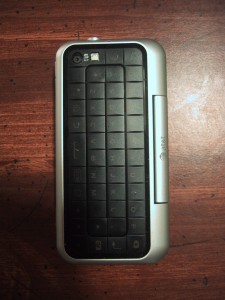
Hardware:
The screen quality is good, and the 3.1 inch 320×480 resolution display is perfectly fine for all of the applications and web browsing I have used it for. I’ve been happy with the display quality and brightness (although I intentionally dimmed the display after using PowerTutor to determine that it used more power than the CPU when lit). The capacitive touch screen has worked as I’d expect.
The hinge mechanism that folds the keyboard around from the back to the front has been solid. The keyboard, although flat, offers at least as good tactile feedback as my Razor’s, and having one available has made sending emails or commenting on Facebook posts much easier. I was unsure if I would need a QWERTY keyboard, but now that I have it, I’m wondering if I could do as well with an on-screen keyboard. (I almost never try and use the on-screen keyboard, instead flipping the phone open to use the hardware QWERTY, even though this requires a vertical to horizontal flip of the GUI.)
When you open the phone “halfway” it will sit on the keyboard (back) side and have a vertical “clock mode” display that is nice for nightstand or tables, and can be used as a mini digital picture frame.
The back of the screen has a “BackTrack” touch-pad which can be used when the phone is folded open. At first I though that this feature would allow me to select anything on the screen with one touch, kind of like a touch-screen on the back of my regular screen. It does not act like that. Instead, it responds to relative commands to highlight focusable items (links, buttons, etc) and then select them. So, for example, if you want to click the third link down in a web page, you have to slide your finger in a downward motion. The UI will highlight each link moving down as you do so. When you get to the link you want, you stop sliding, and double-click. This does allow you to select things without “obscuring” the display with your finger, but takes longer than just tapping on links. The only time I really use the backtrack sensor is for scrolling, moving between large buttons, or double-clicking to select the already selected default option. It doesn’t get in my way, and I don’t mind having the extra interactions options available, but I just don’t use it nearly as much as tapping what I want on the front of the screen. (You can disable it in the settings if you don’t like it or if your fat fingers keep accidentally brushing against it.)
One nice thing about having the battery compartment door “inside” the phone (when it’s folded closed) is that when you drop the phone the battery and door don’t automatically go flying (like with my V3xx and V551 phones…). I have a close fitting plastic “snap-on” case around my Backflip to offer it some protection from drops, and in the one drop-test where I learned that the battery and door doesn’t go flying a corner of my case got chipped off. (Superglue to the rescue.) If my other Motorola phones are any indication, this guy can also stand being dropped without having any major issues.)
Size:
The Backflip is larger than my previous daily use Phone (Motorola v3xx razor), but can still fit in a front pocket. It is a bit thicker (mostly due to the keyboard) and makes a larger bulge in a front pocket. I typically carry it around in a cell phone pocket on my backpack. For daily usage, I’d recommend cargo pockets or a belt case. (On those occasions you are leaving the home/office without a backpack or cargo pants, it can be a bit bulky to carry around.)
Speed/Power:
Before purchasing the Backflip I read a lot of reviews that said it was under-powered, had a small screen, etc. From a specification standpoint, many Android phones have faster CPU’s and bigger screens. Every so often I have noticed pauses (mostly when some applications are first starting, when you first turn on the phone, or when switching from vertical to horizontal layout). These pauses are longer than on faster Android phones, but if you are upgrading from an older Feature Phone you probably will be happy enough with the speed. However, if you use a Nexus One, Droid, HTC Aria or other 1Ghz phone running Android 2.1, when you come back to the Backflip it will feel slow and poky. I found the phone to be at least as responsive as my Razor v3xx.
The one place that I really noticed a speed hit was on initial phone boot-up. The Backflip takes almost a minute to boot up when you first turn it on! This is much slower than any previous (non-smart) phone I have owned. It can be annoying when you are on a flight that has landed, and everybody else is telling their family and friends that they have landed, and your phone is just finishing it’s boot-up process. Even after the phone itself is booted it, it usually takes my widgets (I have about 10) another 30 seconds to a minute to draw themselves. Once things get loaded into memory the phone runs fine, but the initial startup is slow. However, as I don’t shut my phone off too frequently, I haven’t really noticed this delay too often.
Radios/Reception:
I have found that the cellular reception is comparable to my Razor (good). I have been very happy with the voice quality. The Backflip has a second microphone to cancel out ambient noise. So far I haven’t really tested it, but nobody has complained about my audio and I haven’t had any dropped calls.
The Backflip is quad band GSM (voice + GPRS/EDGE data) which allows it to work anywhere in the world. However, it’s 3G radio only supports 3 bands (WCDMA 850/1900/2100), which means it mostly does not work on T-Mobile at 3G speeds, and may not support 3G when traveling (especially in Europe). But at least it includes the WCDMA/UMTS-2100 band, which makes it a step above some other AT&T exclusive phones that only have 2 band support [850/1900]. [The iPhone 4 supports all four 3G bands, meaning that it will work with T-Mobile and in all foreign countries at 3G speeds.]
The WiFi signal reception is close to comparable to my laptop (also good). I was especially impressed with the GPS, which acquires a lock faster than my (two year old) Tom-Tom dedicated GPS unit. (I guess the A part of AGPS really helps.) I found that using Wifi Location (allowing Google to collect anonymous usage info…) combined with GPS location gives very good results. Even when the GPS hasn’t locked on, you get 1000′ accuracy from the wifi if you are in any type of town that has already been surveyed, and when the GPS kicks in you get accuracy down to tens of feet.
Speakerphone / Music:
I have continued to be impressed with Motorola’s speakerphones. As with my previous Motorola phones, the speakerphone works very well. It can also be used to play (mono) music, but is a bit tinny (as you’d expect). This speakerphone is better than that on the HTC Aria by a wide margin.
The Backflip has a standard 3.5mm headphone jack, and while I’m not an audiophile, the music sounds just as good from my phone as any other mp3 player I’ve used. I am especially happy with Android’s support for my OGG Vorbis music collection out of the box! I’ve been using the Museek music playing application to handle my multi-gigibyte collection (stored on the micro-SD card).
Camera / Flash / Barcode Reader / Flashlight:
The 5 MP auto-focus camera (with LED flash) is good enough to replace a standard point & shoot camera from 3 years ago. I plan on using it as my main traveling camera (leaving the 2.1MP Cannon with a real lens at home, dedicated to documenting workbench projects…). The flash isn’t quite as powerful as a dedicated camera, but it’s good enough for your standard nightclub shots. The auto-focus camera does a good job at macro shots (such as barcodes or close up shots of flowers).
The Barcode Scanner combined with Google Shopper is one of my favorite applications. (Yes, I’m that person who likes a book at the Bookstore, scans the barcode, and orders it used from Half.com while still in the store…) I have also downloaded the Motorola developed “Backflip Light” application, which allows you to turn on the camera flash to use as a (quite serviceable) flashlight. Here is a sample picture:

Micro-USB cable:
The phone uses a MICRO usb cable, NOT a Mini-USB cable like my previous phone and all my previous phone accessories. I was annoyed at Motorola for switching, as I had to buy a 2nd charger and 2nd data cable with the new “micro” USB end. Plus, my Bluetooth headsets, headphones, and e-book reader are now using a different charger than my phone. On the plus side, even though it’s not the same plug, it is still an industry standard plug, so you can buy chargers and cables from anybody. (And Micro to Mini USB adapters do exist, so with some advance planning I can charge all my devices with a Mini-USB charger and a Mini-to-Micro adapter.)
Web browser:
The standard Android Web browser is very usable. You are aware that you’re looking at at a web page on a phone, but the entire page renders as you’d expect. I haven’t found a standard (non-flash) web page where I haven’t been able to log into and get things done if I needed to (albeit slowly, with lots of scrolling around.) Ebay, Amazon, Sakai, WordPress, they all just work.
Android/MotoBlur:
The Backflip is running Android 1.5 (Update: You can upgrade to 2.1, here). Not having used any other version of android, I felt that 1.5 had all the features I really needed. (The only feature I have heard of but can’t use is WPA Enterprise Encrypted Wifi, animated homescreen backgrounds and the B&N Nook Reader for Android.) I’ll be happy to upgrade when the OTA updates start going out, but I don’t know of any other 1.6, 2.1 or 2.2 feature that I’m really missing by running “only” 1.5. The ability to move applications to the flash card really hasn’t been needed. I have a large list of applications installed, and so far I’m only using up 223MB (of my 336MB total application storage area).
The MotoBlur software that Motorola adds to the stock phone appears to be limited to a “MotoBlur” account setup/login screen when you first start up the phone, social network integration with the contacts/dialer applications, and a few custom widgets on the home screen. The MotoBlur website allows you to track your phone via GPS if it’s lost/stolen, backs up your contacts, and allows you to restore your contacts to a new MotoBlur phone later. I removed the news RSS applications, but kept the “Happenings” application that pulls in my Facebook and twitter feeds. As I haven’t used a “stock” Android phone, I may not be noticing some other MotoBlur features by just assuming that all Android phones “do that”, but I have noticed that the contacts application pulls photos from my Facebook account and lists people’s status messages, which I believe is part of the MotoBlur experience. Overall I have not ran into anything about MotoBlur that made me hate it. Several control panel settings allow you to disable background data downloads, Facebook feed updates, etc. should you not want to use these features. After using the HTC “Sense” UI, I have decided that the MotoBlur “happenings” widget is the best I’ve seen so far for Facebook/Twitter updates.

I did receive one software upgrade (13.37, in two parts) while using the phone, which I downloaded over WiFi. This was a stability and bug-fix patch to Android 1.5. The install/upgrade process took a few minutes, and went flawlessly. It added a new “AT&T Deathstar” logo to the boot-up process (and made the boot-up process appear to take even longer than before). Other than this, I didn’t notice any material improvements from the upgrade, but I was happy with how the phone had worked before the patch.
Unlocking/Rooting the phone:
I was able to buy an unlock code on the Internet for $3 which successfully removed the carrier lock on the phone (so I can use it with T-Mobile, or an international roaming SIM card if I need to), which was easier than trying to get AT&T to give me the code as I had purchased the phone 2nd-hand.
The only real complaint I have about it is that Motorola has done a better than average job of locking it down, so nobody has posted easy to follow “rooting” directions on the web yet. So far there are only two reasons I want root access, which is to make the phone into a wifi hot-spot (useful for traveling), and to replace the stock boot-up animation (not really needed).
Other than wifi-tethering and reading B&N Nook content, everything else I’ve wanted to be able to do with the phone has been easily achievable via applications available (for free) in the Google App Store. Motorola has also made it difficult to “sideload” applications from sources other than the Google App Store. It can be done, you just have to install the Android SDK or Sideload Wonder Machine (which uses the SDK tool) on a computer to do so. (So far I haven’t found any applications that I needed that were not in the Google App Store, so it hasn’t been an issue for me.)
Battery Life:
The Backflip wants to be fed at least once a day, and prefers to have a top-up at lunch. This is NOT a phone you can leave in your purse all week and be ready to make a call on Friday.
Unplugging my phone from the charger at work, taking it home but not plugging it in at home, and bringing it back to work the next day resulted in a battery charge of 65%. That’s 35% used over 16 hours being almost entirely idle. (I had used the phone for no more than 20 minutes.) The battery drains noticeably faster when you are traveling (and the radio has to constantly switch cell phone towers) than when you are static.
Although the standby time isn’t great, the “talk-time” (or rather, surfing the Internet, checking email, and updating Facebook time) of the phone is relatively good. You can use it continuously (for talking, or surfing) for around six hours. If you plug it in every night, you shouldn’t have any problems under normal usage scenarios. If you are the type of person who spends your two hour commutes playing mobile video, (or if you sometimes forget to plug the phone in at night) you may want to invest in a charger
at the office. If you plug it in at night and also charge it at the office, the battery will never go below 75% charged, and have plenty of reserve power for heavy usage.
Overall:
Overall I’ve been very impressed with the new capabilities of the Android phone. I’ve had Motorola phones for the last five years (V551, V3xx) and I’m also happy with the Backflip. For a low cost Android phone, it really shines.
I am going to be trying out an HTC Aria next. The Aria has a smaller form factor, no keyboard, faster processor, and runs Android 2.1 out of the box, but otherwise it has almost exactly the same specifications.
The smaller form factor and easy availability of rooting instructions and tools online may win me over to the Aria, but it costs about twice what the Backflip did, and I have a hunch that I’ll really miss the QWERTY keyboard.
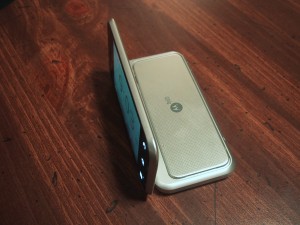
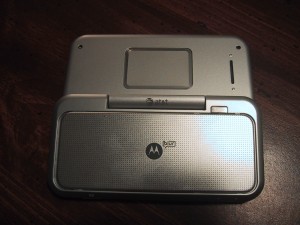



After you unlocked the phone so you can use it with T-mobile does the LED light still work?
Frances,
Unlocking the phone has no effect on the LED flashlight (camera flash LED).
Jay
I bought my BackFlip at an AT&T store before the year was out.
I’ve had Motorola phones also for years.
I have updated my backflip to cyanogen(non-official version Android 2.2 and after doing all the rooting, took me one day almost) and now working very fine for me.
I would be interested in having a link to the directions for that as cyanogenmod doesn’t officially support the backflip.
Also, people should know that Motorola has released an official update for the backflip to android 2.1. You have to manually download and install it, but it gives the backflip most major functionality that it was lacking:
http://www.motorola.com/Support/US-EN/Android_Products/Software_Update_Landing_Page/Backflip_Software_Update_Page
Hi Jay,
I bought an unlocked backflip because like you I would like to use it in Europe.
Your review on the phone was super helpful and one of the best I read, thanks.
I do need some help if you can help. I tried to download Ringdroid and it won’t let me. A window comes up and said that for my security it won’t let me download because it comes from an untrusted source. Is ther a way around this? BTW Ringdroid is a safe site.
Or else do you know of another free app that does what Ringdriod does?
Thanks……………………..Carl
Hi Carl,
You will have to “sideload” the application. Which means you have to download the app to your computer, then install is via a USB cable (typically using a tool designed for that, or the Android SDK).
Jay
Me again. I did upgrade my phone to2.1 thanks to your help…………………..Carl
Jay,
Is it possible to upgrade the Andriod version, thought mine is an unlocked one? Please advise.
Many thanks
Sangeeth
Sangeeth,
If you want to upgrade to Android 2.1 you can do that by downloading the official update directly from Motorola.
See my post on the topic here:
https://www.summet.com/blog/2011/01/15/motorola-backflip-android-2-1-upgrade/
You do not need to root your phone for this. I have heard rumors of people building a custom firmware with even later versions of android, but I was happy enough with the Motorola official 2.1 firmware.
Are there extended life batteries for this phone, and would it be possible to get it unlocked
I don’t believe extended life batteries exist (because the battery fits “inside” the phone when it is folded, so you can’t make it any larger unless you never plan on folding the keyboard away). You can always just buy and carry extra batteries (but you’ll have to turn it off and then boot it back up again after you swap the batteries.
You can certainly get the phone unlocked, I did it online for a minimal charge.